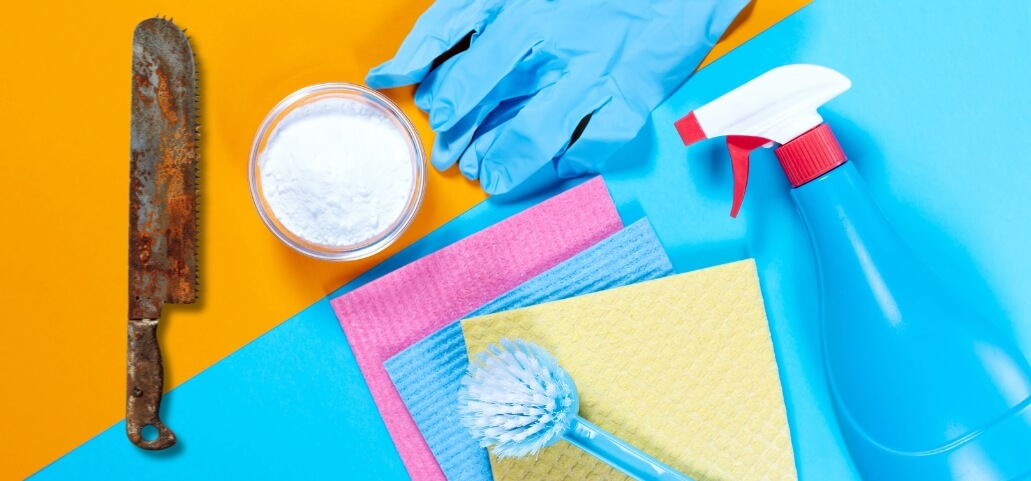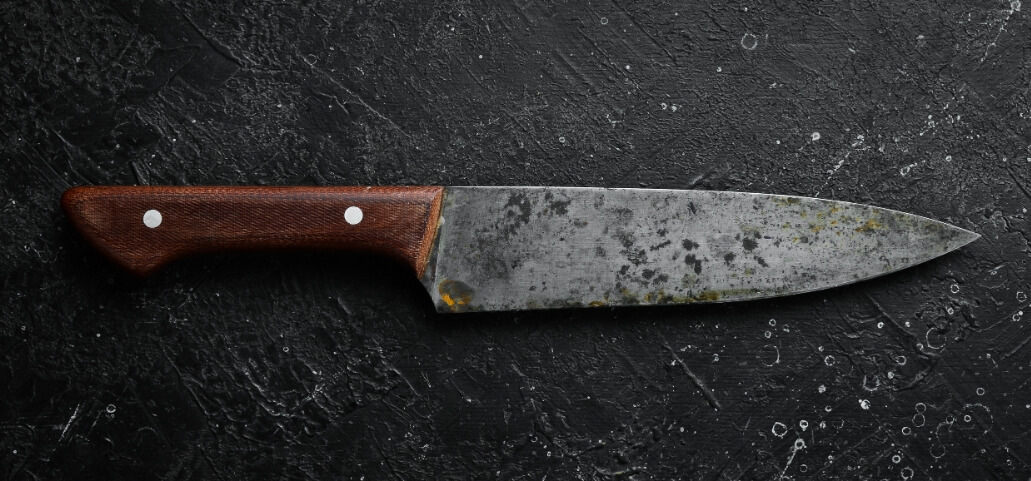Learning how to remove rust from knives can save you money and ensure your knives stay in top condition. Keeping your knives rust-free is essential for maintaining their performance and longevity. Rust can not only dull the blade but also make it unsafe to use. This guide will walk you through various effective methods to remove rust from knives using common household items and tools. With this advice, you can smoothly recover your knives to their original shine and sharpness. So let’s dive in and explore how to remove rust from knives.
The Importance of Rust-Free Knives
Before we go into the ways to remove rust, let’s figure out why it’s so important to prevent corrosion from occurring on your blades. Firstly, rusty knives are less effective and efficient in cutting and chopping food. The rough surface caused by rust can make it difficult to achieve clean cuts and can even leave behind metallic flakes in your food. Additionally, if left untreated, rust can weaken the blade, making it more prone to breaking or chipping. This not only compromises the quality of your knife but also poses a safety hazard while using it.
Benefits of Maintaining Rust-Free Knives
Regular maintenance and rust removal prolong the life of your knives, ensuring they remain reliable tools in your kitchen. Clean, rust-free knives also maintain their sharpness longer, making food preparation easier and more enjoyable. Plus, a well-maintained knife is a joy to use and a source of pride for any culinary enthusiast.
Tools and Materials Needed for Rust Removal
Before you start removing rust from knives, gather the following tools and materials:
- Sandpaper (various grits)
- Baking Soda
- Vinegar
- Lemon Juice
- Salt
- Rust Erasers
- Protective Gloves
Step-by-Step Methods to How to Remove Rust from Knives

Now that you have all the necessary tools and materials, let’s dive into the five methods to remove rust from knives:
Method 1: Using Baking Soda Paste
To complete this task, you will need baking soda, water, and a soft cloth or sponge. First, gather these items and ensure you have enough space to work. For a paste, combine the baking soda and water; then, using a gentle cloth or sponge, apply the mixture to the surface of your choice.
Detailed Step-by-Step Process:
- To make a paste, combine the baking soda with the water and stir until well combined.
- Apply the paste to the rusted areas of the knife, covering them completely.
- Let the paste sit for 15-20 minutes.
- Use a toothbrush or sponge to scrub the rusty areas and remove any loose rust particles.
- Remove any remaining paste by rinsing with warm water and patting dry with a fresh towel.
- If any rust remains, repeat steps 1-5 until all rust is removed.
Tips for Best Results:
- Apply gentle pressure to avoid scratching the blade.
- If the rust spots are really difficult to remove, try again.
Method 2: Soaking in Vinegar Bath
To get started, you’ll need some white vinegar, water, a container or bowl, and a soft cloth or sponge. A clean work area and all necessary supplies should be gathered first. Measure out equal parts of white vinegar and water, then mix them together in the container or bowl. Dip the cloth or sponge into the mixture, and you’re ready to begin cleaning.
Detailed Step-by-Step Process:
- Soak the corroded parts of the blade in a basin of white vinegar.
- Place the knife in the vinegar bath and let it soak for 30 minutes to an hour, depending on the severity of rust.
- Use a toothbrush or sponge to scrub off loosened rust particles.
- After rinsing with warm water, wipe off the vinegar with a clean towel.
- If any rust remains, repeat steps 1-4 until all rust is removed.
Tips for Avoiding Damage to the Knife:
- Avoid soaking the knife for too long to prevent damage to the blade.
- Avoid damaging the knife by wiping it with a soft, nonabrasive cloth.
Method 3: Using Lemon Juice and Salt
For this task, you will need lemon juice, table salt, and a soft cloth or sponge. The lemon juice will act as a natural cleaner, the table salt will provide gentle abrasion to help remove stains, and the soft cloth or sponge will ensure you can apply the mixture without damaging the surface.
Detailed Step-by-Step Process:
- Cut a lemon in half and sprinkle salt over one half.
- Rub the salted lemon half on the rusted areas of the knife, squeezing the juice as you go.
- Let it sit for 5-10 minutes.
- Use a toothbrush or sponge to scrub off loosened rust particles.
- Use warm water to rinse the salt and lemon juice off, and then pat dry with a clean cloth.
- If any rust remains, repeat steps 1-5 until all rust is removed.
Tips for Effective Rust Removal:
- Use fresh lemon juice for best results.
- If the rust spots are really difficult to remove, try again.
Method 4: Using a Rust Eraser
To get started, you’ll need a rust eraser (like a Sabitoru or Sandflex), water, and a soft cloth or sponge. The rust eraser gently scrubs away rust without damaging the surface. Water acts as a lubricant, making the method sleek and more effective. The soft cloth or sponge wipes away residue and cleans the surface after rust removal. Have these items ready before you begin for the best results.
Detailed Step-by-Step Process:
- Use a dry, fine-grit sandpaper or specialized rust eraser to gently rub away rust from the blade.
- Work in a circular motion.
- Remove any remaining residue by using a clean cloth.
- If there are stubborn spots, use a dampened fine-grit sandpaper or rust eraser to continue removing the rust.
- Rinse off the blade with warm water and dry thoroughly with a clean cloth.
- If any rust remains, repeat steps 1-4 until all rust is removed.
Tips for Safe Handling of Rust Erasers:
- Wear protective gloves to keep flesh from coming into direct touch.
- Be cautious when using rust erasers on softer metals, as they can cause scratches.
Method 5: Sandpaper Treatment
To complete this project, you will need sandpaper in various grits, ranging from coarse to fine, to achieve a smooth finish. Additionally, protective gloves are essential to safeguard your hands during the sanding process. A soft cloth or sponge will be necessary for wiping down surfaces and ensuring a clean, dust-free work area.
Detailed Step-by-Step Process:
- Start by using coarse-grit sandpaper (around 100 grit) to remove the majority of rust from the knife’s blade.
- Gradually switch to finer grits (around 320-600) to remove any remaining rust and smooth out the blade.
- Remove any remaining residue by using a clean cloth.
- If there are stubborn spots, use a dampened fine-grit sandpaper to continue removing the rust.
- Clean the blade by rinsing it with warm water and then drying it well with a fresh towel.
- If any rust remains, repeat steps 1-5 until all rust is removed.
Tips for Avoiding Scratches:
- Sand in the direction of the blade to minimize scratches.
- Use light, even pressure.
Tips for Preventing Future Rust
If you want to keep your blades from rusting in the future, follow these tips:
- Dry knives immediately after washing or wiping them down.
- Avoid leaving them to air dry.
- Store knives in a well-ventilated area, away from moisture and humidity.
- Use a mineral oil or specialized knife oil to protect the blade from moisture and rust.
- Clean your knives after cutting acidic foods to prevent any acid residue from corroding the blade.
Conclusion
Maintaining knife performance and safety hinges on knowing how to remove rust effectively. Rust diminishes blade sharpness and can pose health risks if ignored. Methods such as using vinegar, baking soda, or commercial rust removers can efficiently eliminate rust, ensuring your knives stay in prime condition. Key to prevention is routine maintenance: immediate cleaning, thorough drying, and proper storage using knife blocks or magnetic strips. By adopting these practices, your knives will remain reliable kitchen tools, ready for any cutting task.
Frequently Asked Questions
Q1: How to remove rust from knives without damaging the blade?
Answer: Scrub gently with baking soda, vinegar, or lemon juice, or any other non-abrasive substance. Avoid soaking the knife for too long, and always dry the knife thoroughly after cleaning.
Q2. Can I use these methods on any type of knife?
Answer: Yes, these methods are generally safe for most types of knives. But before you do anything major, make sure a tiny, hidden region is OK by testing it.
Q3. Is it safe to use a rusty knife?
Answer: No, using a rusty knife can be unsafe. Rust weakens the blade and can harbor harmful bacteria, posing health risks.
Q4. Can I use a dishwasher to clean my knives?
Answer: It’s best to avoid using a dishwasher for cleaning knives, as the high heat and moisture can promote rust and damage the blade.
Q5. What should I do if the rust doesn’t come off?
Answer: If rust persists despite using the methods outlined, consider seeking professional help or using specialized rust-removal products designed for knives.
Disclaimer: The methods outlined in this guide are intended for removing rust from kitchen knives only. Be very careful and take all necessary precautions if you are working with sharp instruments. Injuries or damages caused by using these methods are not the author’s fault. It is always best to consult a professional or manufacturer for specific care instructions for your particular knife. Remember to always use caution and handle knives safely.
Personal Experience: As a cooking enthusiast, I used to discard rusted knives believing they were beyond repair. However, after discovering effective rust removal methods, such as soaking in vinegar, I was able to restore many of my favorite kitchen tools. This not only saved me money but also enhanced my cooking safety and efficiency. Regularly checking and maintaining knives has become a key part of my routine.
Why Trust Our Content?
Professionals in the fields of culinary and home repair write and conduct extensive research for our material. We have consulted with professionals, and manufacturers, and tested these methods ourselves to ensure their effectiveness and safety. Our goal is to provide reliable information to help individuals take proper care of their knives and extend their lifespan. Trust our content for accurate and practical solutions for all your kitchen needs.

